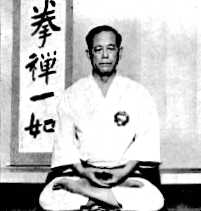Shoshin Nagamine
| Shōshin Nagamine | |
|---|---|

Shōshin Nagamine, sitting in the lotus position
|
|
| Born |
15 July 1907 Naha, Okinawa |
| Died | 2 November 1997 (aged 90) Naha, Okinawa |
| Style | Matsubayashi-ryu |
| Teacher(s) | Taro Shimabuku, Ankichi Arakaki, Chotoku Kyan, Motobu Choki |
| Rank | Hanshi, 10th Dan |
| Notable students | Chokei Kishaba, Takayoshi Nagamine, Katsuhiko Shinzato, Ansei Ueshiro, J. Eduardo Castro |
Shōshin Nagamine (長嶺 将真 Nagamine Shōshin?, 15 July 1907 – 2 November 1997) was a Japanese author from Okinawa as well as a soldier, police officer, and karate master.
Nagamine was born in Tomari, in Naha, Okinawa. He was a small and sickly child, and he contracted a gastroenteric disorder in 1926, his second year of high school. He began a self-imposed diet and took up karate under the watchful eye of his next-door neighbour, Chojin Kuba. Nagamine soon became a picture of good health, crediting his recovery to "hard work both at school and training of Karate"[1]. His health improved to such an extent that he became a leader of the school's karate club, and his friends dubbed him Chippaii Matsu, a nickname meaning "tenacious pine tree".
After graduation in March 1928, he began to study martial arts full-time, moving to Shuri and training under Taro Shimabuku (島袋善良)and Ankichi Arakaki. Later that year, he was conscripted into the Japanese army in the 47th Infantry Division, and fought in China before receiving an honourable discharge in 1931.
Leaving the army, Nagamine sought an area in which his martial arts abilities would be useful, eventually settling on the police force.
During his time as a police officer, Nagamine received further instruction in karate from Chotoku Kyan and Motobu Choki, and achieved the title of Renshi in 1940. By 1951, Nagamine was a Police Superintendent, of Motobu, and was training his own officers in karate.
...
Wikipedia
